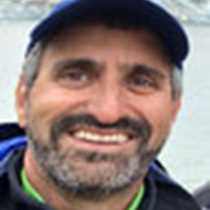Isispynten & Kvitoya
Protruding from the ice-encased islands of eastern Svalbard are but a few small stretches of land. These exposed rock and scree beaches represent some of the most remote and desolate lands on Earth. Today we explored two of these rarely-visited places which reveal the presence of land under enormous ice masses.
Along the southeastern shore of Nordaustlandet we ran along surreal hundred-mile long ice cliffs considered the island’s coastline to the emerging Isis Point. In Norwegian the name is pronounced “ice-ice” cleverly adding double meaning to the Egyptian goddess and river at Oxford for which it is named. Once considered a point of land, we used our Zodiacs to circumnavigate the mile-long island.
Remote land in a world of ice and sea provides refuge and habitat. With the pack ice now out, it was not surprising to find polar bears ashore at Isispynten. Two siblings lay by a lagoon as we watched from our Zodiacs. Eiders and terns nested on the barren landscape. Kittiwakes perched on pure blue icebergs grounded on the shoals. From the water we viewed the improbable edge of Nordaustlandet's ice cap hiding terra firma. Inconceivably a mother and cub polar bear were wandering up on the ice slopes. Trying to describe where to look to others conjured the old cliché of the white on white of a polar bear in a snowstorm.
Heading for the farthest eastern reaches of Svalbard a mere sixty miles from Russia, we first detected the ice-enveloped island of Kvitoya (“White Island”) by a bright white line of ice blink on the horizon. A thin edge of land called Andréeneset emerges from under the island’s defining ice dome at its western end. This remote scrape of shore stuck between ice and ocean is a place of some refuge. Polar bears ashore deterred us from landing at first. Clouds of arctic terns darkened the sky. Zodiac explorations reached elevated levels as thickets of tusked walruses encircled our rubber boats. The season’s best walrus experience was a surprise finding at Kvitoya: we estimated more than four hundred of these massive pinnipeds – real life constructions of imagination.
In 1897, in an age of exploration and nationalism, Swedish engineer Salomon August Andrée attempted the North Pole by hot air balloon, a most intriguing chapter in polar exploration. In competition with Nansen and Norway, Andrée and two companions lifted off from northwestern Spitsbergen. Besides one carrier pigeon and two floats bearing messages, no word was heard for thirty-three years. Ultimately their remains were discovered on this desolate beach on Kvitoya. Journals and undeveloped film recreated the past; their balloon came down on the ice after three days and they survived a 100-day trudge over floes and leads to find inhospitable refuge at Kvitoya where they perished. After dinner and after scouting for bears, we made an exciting landing at a monument to Andrée marking where this man and his belief in technology over nature ended.
Protruding from the ice-encased islands of eastern Svalbard are but a few small stretches of land. These exposed rock and scree beaches represent some of the most remote and desolate lands on Earth. Today we explored two of these rarely-visited places which reveal the presence of land under enormous ice masses.
Along the southeastern shore of Nordaustlandet we ran along surreal hundred-mile long ice cliffs considered the island’s coastline to the emerging Isis Point. In Norwegian the name is pronounced “ice-ice” cleverly adding double meaning to the Egyptian goddess and river at Oxford for which it is named. Once considered a point of land, we used our Zodiacs to circumnavigate the mile-long island.
Remote land in a world of ice and sea provides refuge and habitat. With the pack ice now out, it was not surprising to find polar bears ashore at Isispynten. Two siblings lay by a lagoon as we watched from our Zodiacs. Eiders and terns nested on the barren landscape. Kittiwakes perched on pure blue icebergs grounded on the shoals. From the water we viewed the improbable edge of Nordaustlandet's ice cap hiding terra firma. Inconceivably a mother and cub polar bear were wandering up on the ice slopes. Trying to describe where to look to others conjured the old cliché of the white on white of a polar bear in a snowstorm.
Heading for the farthest eastern reaches of Svalbard a mere sixty miles from Russia, we first detected the ice-enveloped island of Kvitoya (“White Island”) by a bright white line of ice blink on the horizon. A thin edge of land called Andréeneset emerges from under the island’s defining ice dome at its western end. This remote scrape of shore stuck between ice and ocean is a place of some refuge. Polar bears ashore deterred us from landing at first. Clouds of arctic terns darkened the sky. Zodiac explorations reached elevated levels as thickets of tusked walruses encircled our rubber boats. The season’s best walrus experience was a surprise finding at Kvitoya: we estimated more than four hundred of these massive pinnipeds – real life constructions of imagination.
In 1897, in an age of exploration and nationalism, Swedish engineer Salomon August Andrée attempted the North Pole by hot air balloon, a most intriguing chapter in polar exploration. In competition with Nansen and Norway, Andrée and two companions lifted off from northwestern Spitsbergen. Besides one carrier pigeon and two floats bearing messages, no word was heard for thirty-three years. Ultimately their remains were discovered on this desolate beach on Kvitoya. Journals and undeveloped film recreated the past; their balloon came down on the ice after three days and they survived a 100-day trudge over floes and leads to find inhospitable refuge at Kvitoya where they perished. After dinner and after scouting for bears, we made an exciting landing at a monument to Andrée marking where this man and his belief in technology over nature ended.



